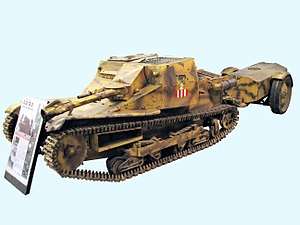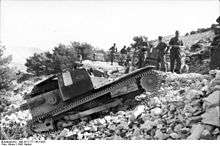L3/33
The Carro Veloce 33 (CV 33) or L3/33 was a tankette originally built in 1933 and used by the Italian Army before and during World War II. It was based on the imported British Carden Loyd tankette (license-built by Italy as the CV 29). Many CV 33s were retrofitted to meet the specifications of the CV 35 in 1935. In 1938, the CV 33 was renamed the "L3/33" while the CV 35 became the "L3/35s."
| Carro Armato L3/33 | |
|---|---|
 Italian L3/33 (CV-33), Flamethrower variant at The Tank Museum, Bovington | |
| Type | Tankette |
| Place of origin | Italy |
| Service history | |
| In service | 1933–1945 |
| Used by | Italy, and others |
| Wars | Austrian Civil War, Second Sino-Japanese War, Second Italo-Abyssinian War, Spanish Civil War, Slovak–Hungarian War, Invasion of Albania, Anglo-Iraqi War, and World War II |
| Production history | |
| Designer | Ansaldo |
| Unit cost | 89,890 lires in 1933 |
| Produced | 1933–1935 |
| No. built | 1,200 L3/33; 1,300 L3/35 |
| Variants | L3/35, L3 cc, L3 Lf, |
| Specifications | |
| Mass | 2.7 tonnes |
| Length | 3.03 m (9 ft 11 in) |
| Width | 1.4 m (4 ft 7 in) |
| Height | 1.2 m (3 ft 11 in) |
| Crew | 2 (commander and driver) |
| Armour | 6–12 mm (0.24–0.47 in) |
Main armament | 1 × 6.5 mm machine gun |
| Engine | FIAT-SPA CV3 water-cooled 43 hp (32 kW) |
| Suspension | bogie |
Operational range | 110 km (68 mi) |
| Maximum speed | 42 km/h (26 mph) |
The original CV 33 carried a two-man crew protected by 12 mm of welded armour and was armed with a single 6.5 mm machine gun.
The L3/33 saw action in China, Spain, France, the Balkans, North Africa, Italian East Africa, Italy, and Russia.
Variants
L3 Lf
Development of the "L3 Lf" (Lancia fiamme, "flamethrower") flame tank, based on the L3 tankette, began in 1935. The flamethrower nozzle replaced one of the machine guns, and the flame fuel was carried in an armoured trailer towed by the vehicle.[1] Later versions had the fuel carried in a box-shaped tank mounted above the L3's engine compartment. The vehicle weighed 3.2 tons, and the armoured trailer carried 500 litres (110 gallons) of fuel.[2] It had a range of 40 meters (130 feet), though other sources report a 100 meters (330 feet) range.[2] They were fielded in North Africa, although there is no record of them being involved in combat there.[3]
The L3 Lf saw action in the Second Italo–Abyssinian War, China, Spain, France, Russia, the Balkans, Italian North Africa and Italian East Africa.
Artillery tractor
Footage exists of an unarmed, open-topped, artillery tractor based on the L3.[4] This could be used to tow a tracked trailer, as could the L3, as well as light artillery pieces, including a 100mm mountain howitzer. This vehicle does not appear to have entered production.

Operators



.svg.png)
.svg.png)
.svg.png)
_crowned.svg.png)

.svg.png)
.svg.png)
Survivors
One example of the L3/33 is on display in the Australian War Memorial in Canberra, Australia. It is believed this example was captured by British and Commonwealth troops in North Africa in 1940 or 1941.[10] There is also a flame thrower variant on display at The Tank Museum in Bovington. There is also an example on a plinth at 305 Corps HQ at Kandahar Air Field, Afghanistan. A former Chinese Nationalist operated example, captured by the Communists in 1949, is on display at the Chinese People’s Revolution Military Museum in Beijing. One example captured by the Yugoslav Partisans during World War II is on open display of the Belgrade Military Museum in Serbia.
At least one example was in running order in 2014.[11]
Notes
- "Flame-Throwing Tank Practices For War" Popular Mechanics, August 1937
- Forty 2006, p 73
- CV-33 accession record The Tank Museum
- Vehicules a chenille Ansaldo
- Mahé, Yann (June 2010). "Le Blindorama : L'Autriche, 1919 - 1938". Batailles & Blindés (in French). No. 37. Caraktère. pp. 4–5. ISSN 1765-0828.
- Zaloga 2013, p. 33.
- Boisdron, Mathieu (December 2010). "Le Blindorama : La genèse de la force blindée bulgare 1935 - 1943". Batailles & Blindés (in French). No. 40. Caraktère. pp. 4–7. ISSN 1765-0828.
- Mahé, Yann (April 2011). "Le Blindorama : La Croatie, 1941 - 1945". Batailles & Blindés (in French). No. 42. Caraktère. pp. 4–7. ISSN 1765-0828.
- Zaloga 2013, p. 10.
- Italian tankette arrives in Canberra ABC News. Retrieved 2015-08-25
References
- Forty, George (2006). The complete guide to tanks and armoured fighting vehicles. Hermes House. ISBN 978-1-84681-110-4.
- Zaloga, Steven J. (20 Apr 2013). Tanks of Hitler’s Eastern Allies 1941–45. New Vanguard 199. Osprey Publishing. ISBN 9781780960203.
External links
| Wikimedia Commons has media related to L3/33. |
- L3/33 (CV 33), L3/35 (CV 35) Tankettes at wwiivehicles.com